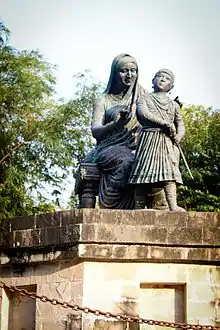Jijamata Udyaan
Veermata Jijabai Bhonsale Udyan, also known as the Byculla Zoo, is a zoo and garden covering 50 acres located at Byculla, in the heart of Mumbai, India. It is the oldest public garden in Mumbai.[3] After Indian independence it was Named after Jijamata, the mother of Shivaji , the first Maratha emperor.
 Statue of Jijamata and Shivaji at Jijamata Udyan(Byculla Zoo) | |
| Date opened | 1861 |
|---|---|
| Location | Mumbai, India |
| Coordinates | 18.9781154°N 72.8367457°E |
| Land area | 50 acres (20 ha) |
| Memberships | CZA[1] |
| Jijabai Udyan & Zoo | |
|---|---|

| |
| Type | Botanical Garden & Zoo |
| Location | Mumbai (Maharashtra) |
| Area | 50 acres |
| Owned by | Municipal corporation of greater Mumbai |
| Operated by | Director Zoo, MCGM, Mumbai |
| Visitors | 8000 to 30,000 (on holiday) |
| Status | Open |
| Species | 843 [2] |
| Collections | Sundari(glass pane tree), Castanospermum australe, Coccoloba uvifera |
In 1835, British administration granted a large plot of land in Sewri to the Agro Horticultural Society of Western India for a botanical garden. That land was later acquired for a European burial ground.[4] In 1861, construction of a new garden was commenced on 33 acres in the Mount Estate, Mazgaon (now included in Byculla). The flora from Sewri garden was transferred to this new garden named Jijamata Udyaan which was formally opened to the public by Lady Frere on 19 November 1862. Agro Horticultural Society of Western India continued to maintain Victoria Gardens till 1873 when the society's end led to the municipal corporation taking over the garden's upkeep. In 1890 the garden was extended by 15 acres especially for the zoo.[3]
The garden also houses the Dr. Bhau Daji Lad Museum, a staff building in Greco-Roman style erected in the memory of Lady Frere, an equestrian statue of King Edward VII of England made of black marble (originally installed near the University of Mumbai) known as Kala Ghoda and the David Sassoon clock tower.[4]
| Wikimedia Commons has media related to Jijamata Udyan. |
 The original Kala Ghoda
The original Kala Ghoda David Sassoon Clocktower
David Sassoon Clocktower Dr. Bhau Daji Lad Museum, Byculla
Dr. Bhau Daji Lad Museum, Byculla
Notes
- "Search Establishment". cza.nic.in. CZA. Retrieved 4 July 2011.
- "The varied flora of Rani Bagh's heritage botanical garden - Mumbai's largest green open public space". Save Rani Bagh Botanical Garden Foundation. Retrieved 3 February 2019.
- "PLACES". Maharashtra State Gazetteers-Greater Bombay District. Archived from the original on 14 June 2011.
- "Mumbai's Byculla Zoo: A testament to the period that shaped city's architectural landscape". The Indian Express. 1 May 2016. Retrieved 29 January 2021.